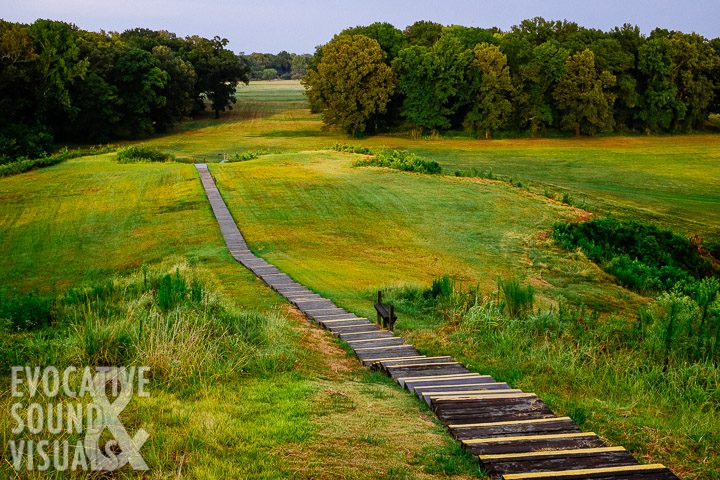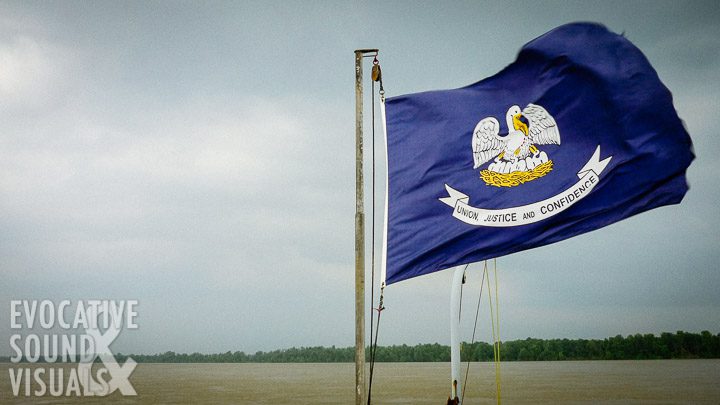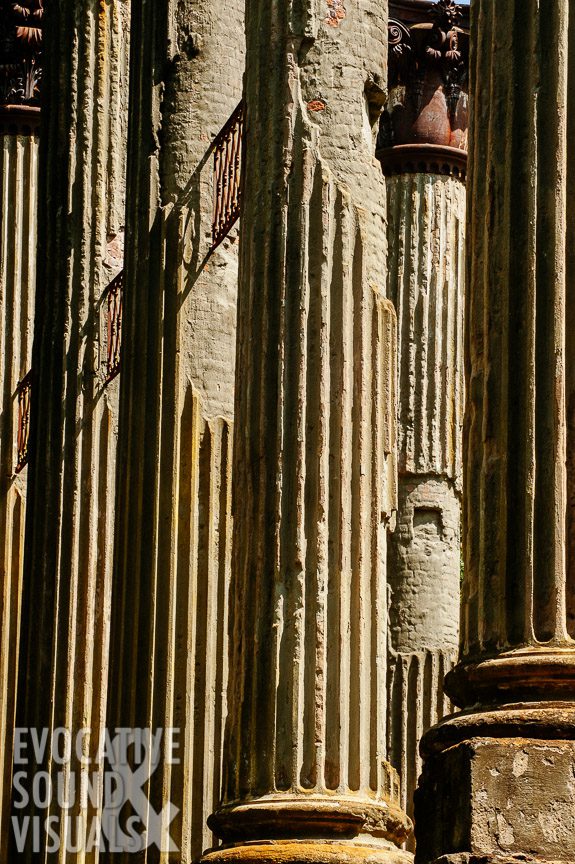Come, and take a 500-mile sonic journey with me through the Deep South in August. It’s the time of year when the humidity is so thick it smacks you right in the face morning, noon and night. That time of year when sweat drips down your back, past your knees and forms puddles in your shoes from the moment you walk out the door. August in the Deep South, despite its unrelenting mugginess, is when nature’s soundscape swirls along. Listen to my Deep South Memories.

I lived in the Deep South for 15 years, a voluntary prisoner of the stifling August heat. For reasons that became readily apparent with each passing summer, we never had Yankee relatives come down in August. Plus, it’s prime hurricane season too. Too dangerous they’d say. But I love this weather. So hop in my convertible (wishful thinking) and let’s get moving.
Our first stop is near the Mississippi River north of Baton Rouge. We arrive at dawn, content to sit for a spell against a majestic Southern live oak. Its sprawling branches, and the Spanish moss hanging off them, are twirling in a light breeze. We listen to what aspiring ornithologist and illustrator John James Audubon might have heard while walking through the woods in search of birds to paint during his brief visit to this country in 1821. Aware of our presence, a whitetail deer to our left repeatedly snorts and stamps its hooves. Woodpeckers drum up above. A peacock calls out from a distance, its screams reflecting off the thick old trees. Crows make a fuss while a mourning dove tries to keep the peace.

Next up on our journey is Poverty Point in northeast Louisiana. We get into some rain. It’s August remember. Rain is a given. We stand atop one of the remaining grass-covered ceremonial mounds. Now a World Heritage site, this location was once home to a thriving civilization. The rain picks up and thunder rolls in. We take shelter after hearing two cracks too close for comfort. Rolling thunder gives way to the incessant sound of cicadas singing en masse. One wonders what the indigenous people who lived and worshiped here were like. What did they make of these sounds? Did they hate the sound of cicadas as much as we do? What sounds did they create and listen to that we will never hear?

To escape the high-pitched song of these annoying little insects, we take a five-minute ferry ride across the Mississippi River. The river is nearly a mile wide at this point. Upon departure, the captain lays on the boat’s horn, creating an unexpected echoing blast that shakes us out of our boots as we stand front and center at the bow. The 1,000-plus horsepower flat-decked white boat jammed full of cars, grinds into reverse before lurching forward. It chops its way through muddy water at a clip that makes the Louisiana state flag flap in the stiff breeze.

We are off to another soundscape of the disappeared. This time to Windsor Ruins, an antebellum home, or rather, what’s left of one. Windsor mansion was completed in 1861, just in time for the Civil War. Its cupola became a perfect perch, for both Southern and Union troops, to watch over the river. Back then the Mississippi meandered much closer to the home than it does today. A third-floor fire in 1890 burned all but the mansion’s 23 Corinthian columns to the ground. A guest dropped cigarette ashes to cause the fire, or a construction worker dropped his cigar. So the stories go. Either way, the place was never quite the same. There is a hum in the air. Birds chatter between the columns. This is a perfect out-of-the-way location to listen to a late summer dawn chorus.



Our next stop downriver is not far away. We head into the woods and away from civilization once more. The sound of someone’s dog barking and a cow mooing cuts through occasionally. For the most part, this soundscape consists of mourning doves, woodpeckers, a back-and-forth mix of exotic-sounding birds I cannot name and morning dew dripping from loblolly pines. The thermometer a little past sunrise hovers at 70 degrees. It would climb to 94 degrees on this day.


Finally, we head down to the Gulf to cool off and escape the sweltering heat. Waveland Beach along the Mississippi Gulf Coast was ground zero for Hurricane Katrina in 2005. Thankfully, the waters are much calmer this day. We begin listening in earnest near the dunes, but the surf beckons. Barefoot, we race down to the shore like fire walkers running over hot coals.
At last, the sound we’ve been waiting to hear all month has emerged. Waves endlessly roll in at our feet. They mix with hot grains of sand and broken shells to create a gentle fizz between our toes. Gulls circle and screech overhead. Our journey through the Deep South has ended. We sit down to rest in the breaking surf.
The end.
Recording note: Each track was originally recorded at 96kHz/24-bit on a Sony PCM M10 recorder using a stereo pair of Luhd PM-01AB microphones, or through the Sony M10 in combination with a Sound Devices Mixpre-D mixer, using Audio Technica 3032 omnidirectional microphones in a baffled omni configuration. The album is CD-quality 44kHz/16-bit.
On the cover: Windsor Ruins at dawn. Stitched panoramic photograph by Richard Alan Hannon. ‘Paper’ used for the cover courtesy Wild textures.
Further reading:
- See copies of the plates from John James Audubon’s masterful work The Birds of America here, at the Audubon Society’s website.
- Learn more about Poverty Point from the National Park Service here, and here, from the Louisiana Office of Tourism & Office of the Lt. Governor.
- Here is a list of Louisiana ferries that will take you across the Mississippi River.
- This page, hosted by a former Waveland, Mississippi resident, shows interesting before and after photos of homes lost to Hurricane Katrina.
- Read about the once-thriving town of Rodney, Mississippi here.
- This page hosted by Natchez Trace Travel shows why the columns at Windsor Ruins have stood the test of time.



